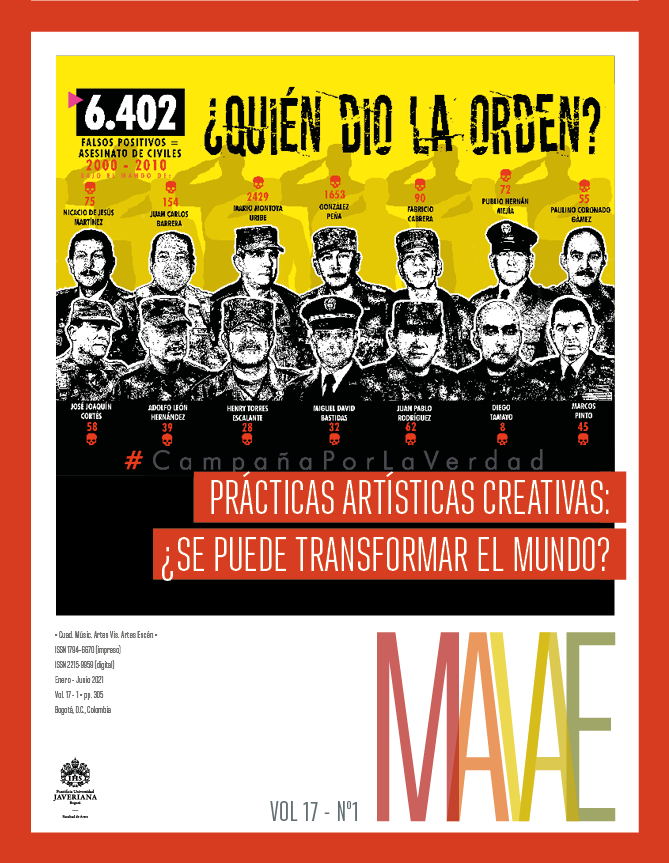Resumen
Este artículo busca articular el movimiento de derrocamiento de estatuas, símbolos de colonización y esclavitud, con la actuación coreográfica de la artista Diambe da Silva en la ciudad de Río de Janeiro entre 2019 y 2020. Primero se contextualiza el papel social y simbólico de las estatuas en el espacio público, y cómo el arte es un vector de cambio a través de una breve revisión bibliográfica de artículos y textos, que destacan el problema de las estatuas de personalidades controvertidas que aún se conservan y mantienen en los espacios públicos y cómo las autoridades y la ciudadanía han abordado este tema en los últimos años. A continuación, se analiza la obra de Diambre, a partir de la elección de las estatuas y su ubicación en Río de Janeiro. El artículo seleccionó tres coreografías de la serie Devolta que ocurrieron en las estatuas de los personajes históricos de Dom Pedro I, Dom João VI y la Princesa Isabel, personalidades recurrentes en las narrativas de la historia colonial brasileña y que jugaron papeles centrales y controvertidos cuando revisamos la narrativa construida de un país que, de colonia, se convierte en imperio y, finalmente, se reconoce como república. Por medio de las coreografías, se les da un nuevo sentido simbólico a las estatuas, localizadas en espacios destacados de la ciudad, conocidas áreas nobles, el barrio de Copacabana y el centro comercial de la ciudad, siendo el último espacio habitacional de la monarquía portuguesa en Brasil. Relacionando los conceptos de Andre Lepecki de coreopolice y coreopolítica con el trabajo de Diambe junto con los pensamientos de Achille Mbembe sobre el destino de las estatuas que representan un pasado colonial opresivo, el artículo hace una lectura crítica del lugar de las estatuas hoy basada en la obra del artista
Bauer, Caroline Silveira. 2019. “Escravidão e memória: as transformações recentes no espaço público espanhol.” Café História. https://www.cafehistoria.com.br/antonio-lopez-memoria-do-colonialismo/.
BBC News. Junho 16, 2020. “George Floyd protests: Man shot in clash over Albuquerque statue.” BBC News. https://www.bbc.com/news/worldus-canada-53060704.
Benjamin, Walter. 1994. Magia e Técnica, Arte e Política - ensaios sobre literatura e história da cultura. Obras escolhidas, volume I, 2ª edição.São Paulo: Editora Brasiliense.
Câmara Municipal do Rio de Janeiro. s. d. “Legislação - Lei Ordinária: Lei nº 5429/2012.” http://mail.camara.rj.gov.br/APL/Legislativos/contlei.n s f / 5 0 a d 0 0 8 2 4 7 b 8 f 0 3 0 0 3 2 5 7 9 e a 0 0 7 3 d 5 8 8 /67120c4c1ae54a6603257a14006d2b1d?OpenDocument.
Corrêa, Roberto L. 2005. “Monumentos, Políticas e Espaço.” Scripta Nova- Revista eletrônica de geografía y ciencias sociales IX (183). https://revistes.ub.edu/index.php/ScriptaNova/article/view/894.
Diambe da Silva. s.d. “Diambe da Silva.” http://cargocollective.com/diambe/Devolta-2020.
Imersões Digitais. s.d. “Imersões digitais.” www.imersoesdigitais.com.Inventário dos Monumentos RJ. 2015. “Inventário dos Monumentos RJ.”http://www.inventariodosmonumentosrj.com.br/.
Izecksohn, Vitor. 2017. “Os monumentos confederados nos Estados Unidos:memória e política.” Café História. https://www.cafehistoria.com.br/monumentos-confederados/.
Knauss, Paulo. 2010. “A festa da imagem: a afirmação da escultura pública
no Brasil do século XIX.” http://www.dezenovevinte.net/obraspknauss.htm.
Lepecki, André. 2011. “Coreo-política e coreo-polícia”. Ilha - Revista de Antropologia 13 (1,2). https://periodicos.ufsc.br/index.php/ilha/article/view/2175-8034.2011v13n1-2p41/23932.
Mbembe, Achille. 2020. “O que fazer com as estátuas e os monumentos coloniais?” Revista Rosa, 2 (2). https://revistarosa.com/2/o-quefazer-com-as-estatuas-e-os-monumentos-coloniais.
Prefeitura da Cidade do Rio de Janeiro. Fevereiro 18, 2015. “Monumentos do Rio de Janeiro rememoram a história da cidade.” http://www.rio.rj.gov.br/web/guest/exibeconteudo?id=5206637.

Esta obra está bajo una licencia internacional Creative Commons Atribución 4.0.
Derechos de autor 2021 Julia Baker


